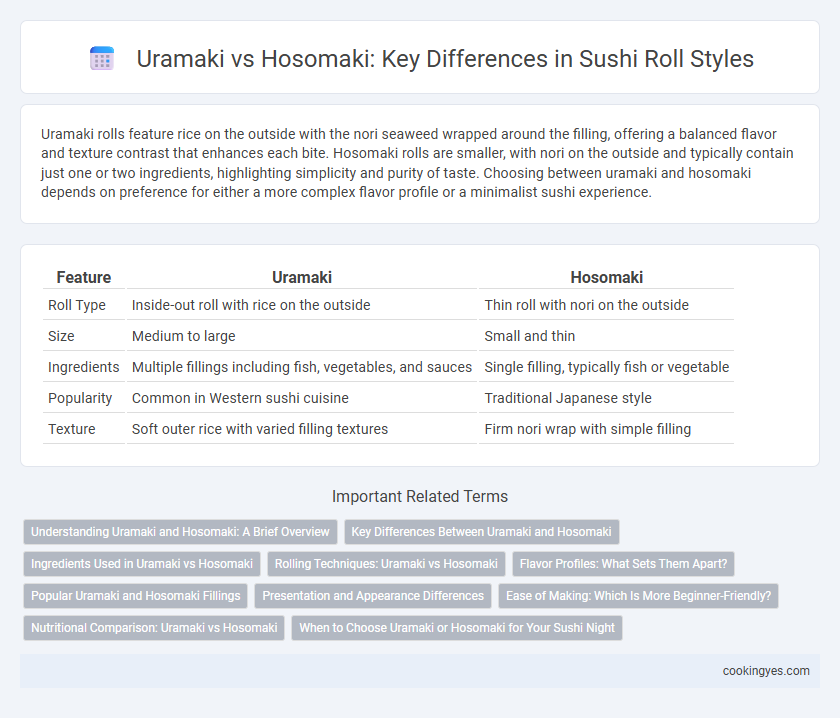Uramaki rolls feature rice on the outside with the nori seaweed wrapped around the filling, offering a balanced flavor and texture contrast that enhances each bite. Hosomaki rolls are smaller, with nori on the outside and typically contain just one or two ingredients, highlighting simplicity and purity of taste. Choosing between uramaki and hosomaki depends on preference for either a more complex flavor profile or a minimalist sushi experience.
Table of Comparison
| Feature | Uramaki | Hosomaki |
|---|---|---|
| Roll Type | Inside-out roll with rice on the outside | Thin roll with nori on the outside |
| Size | Medium to large | Small and thin |
| Ingredients | Multiple fillings including fish, vegetables, and sauces | Single filling, typically fish or vegetable |
| Popularity | Common in Western sushi cuisine | Traditional Japanese style |
| Texture | Soft outer rice with varied filling textures | Firm nori wrap with simple filling |
Understanding Uramaki and Hosomaki: A Brief Overview
Uramaki and Hosomaki are two popular types of sushi rolls distinguished by their size and ingredient arrangement, with Uramaki featuring rice on the outside and seaweed wrapping the filling, while Hosomaki has seaweed on the outside encasing a single ingredient or simple filling. Uramaki, also known as inside-out rolls, often includes multiple ingredients like avocado, cucumber, and seafood, catering to diverse flavor profiles and textures. Hosomaki emphasizes minimalism and balance, presenting traditional tastes such as tuna or cucumber in a slender roll ideal for a subtle sushi experience.
Key Differences Between Uramaki and Hosomaki
Uramaki, also known as inside-out rolls, feature rice on the outside and seaweed wrapping the ingredients inside, enhancing texture contrast and visual appeal. Hosomaki are thin rolls with seaweed on the outside and a single filling, emphasizing simplicity and focused flavors. The key differences lie in the rice placement, roll thickness, and complexity of ingredients, impacting taste and presentation in sushi preparation.
Ingredients Used in Uramaki vs Hosomaki
Uramaki sushi rolls typically feature rice on the outside with ingredients such as avocado, cucumber, and various fish or seafood wrapped inside nori, creating a layered texture and flavor profile. Hosomaki rolls are simpler, usually containing a single core ingredient like tuna, cucumber, or pickled radish wrapped in nori with rice on the inside. The distinct ingredient combinations in Uramaki allow for more complex taste experiences compared to the minimalist approach of Hosomaki.
Rolling Techniques: Uramaki vs Hosomaki
Uramaki and Hosomaki sushi rolls differ primarily in their rolling techniques, with Uramaki featuring an inside-out roll where the rice encases the seaweed and filling, enhancing texture and flavor integration. Hosomaki employs a straightforward roll with seaweed on the outside wrapping a thin layer of rice and a single filling, maintaining a compact structure favored for traditional presentations. These distinct rolling methods influence the sushi's visual appeal, bite size, and ingredient balance, catering to varied culinary preferences.
Flavor Profiles: What Sets Them Apart?
Uramaki sushi rolls, featuring rice on the outside and fillings such as avocado or crab inside, offer a harmonious blend of creamy and tangy flavors contrasted with a slight crunch from sesame seeds or tobiko. Hosomaki rolls, typically smaller with seaweed wrapped tightly around a single filling like cucumber or tuna, deliver a more pronounced and pure taste of the primary ingredient with a subtle umami from nori. The key flavor distinction lies in Uramaki's layered texture and mild sweetness versus Hosomaki's straightforward, intense taste experience.
Popular Uramaki and Hosomaki Fillings
Uramaki sushi rolls, known for their inside-out style with rice on the outside, commonly feature popular fillings such as avocado, cucumber, crab meat, and spicy tuna, offering a flavorful and textural contrast. Hosomaki rolls, thinner and simpler, typically include single-ingredient fillings like cucumber, salmon, or tuna, emphasizing the purity of fresh fish and vegetables. Both styles provide diverse options that cater to different taste preferences and presentation aesthetics in Japanese cuisine.
Presentation and Appearance Differences
Uramaki features rice on the outside with fillings wrapped inside seaweed, offering a visually appealing, colorful presentation often topped with sesame seeds or fish roe for added texture and contrast. Hosomaki presents a more minimalist appearance with seaweed on the outside, tightly enclosing a single filling, resulting in a sleek, uniform roll that emphasizes simplicity and elegance. The distinct external layers and garnishes of uramaki versus the understated, classic look of hosomaki create diverse visual experiences that appeal to different aesthetic preferences in sushi presentation.
Ease of Making: Which Is More Beginner-Friendly?
Uramaki rolls, with rice on the outside, generally require more skill due to the need for precise rolling and handling sticky rice, making them less beginner-friendly compared to Hosomaki. Hosomaki, featuring a thin layer of rice wrapped around a single filling with seaweed on the outside, is simpler and more forgiving for novices learning sushi preparation. Therefore, Hosomaki is typically recommended for beginners aiming to master fundamental rolling techniques before advancing to Uramaki.
Nutritional Comparison: Uramaki vs Hosomaki
Uramaki typically contains more ingredients and rice, resulting in higher calorie and carbohydrate content compared to Hosomaki, which is smaller and features simpler fillings. Hosomaki offers lower fat and protein levels due to its minimalistic design, often consisting of a single vegetable or fish. Uramaki's diverse fillings and outer rice layer contribute to a richer nutrient profile, including increased fiber and micronutrients from added vegetables and toppings.
When to Choose Uramaki or Hosomaki for Your Sushi Night
Choose Uramaki when craving a flavorful, visually appealing sushi roll with rice on the outside and multiple fillings, perfect for social gatherings or adventurous eaters. Opt for Hosomaki for a simpler, traditional experience with just one or two ingredients wrapped in seaweed, ideal for light snacking or sushi beginners. Both offer distinct textures and flavors, making the choice dependent on appetite size and taste preference.
Uramaki vs Hosomaki for sushi rolls Infographic

 cookingyes.com
cookingyes.com